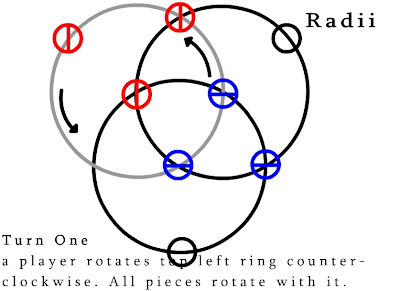 A few days ago I started designing a simple game drawing inspirations from tic-tac-toe, checkers, Palette, and Twist It. Developed at my very own Gryphon Mane Studios, I'm calling the game Radii. Radii is still in development, to be sure though I've already passed through several concepts to arrive at the current favorite. The reason I post this is because I cannot develop further without some help, ideally, from you. Eventually I want to make Radii into an online Flash game, but for now it works quite well as a board game. Basically, I would love for you guys to test out the game and let me know what you think, while also looking for some specific things I'll point out in a bit.
A few days ago I started designing a simple game drawing inspirations from tic-tac-toe, checkers, Palette, and Twist It. Developed at my very own Gryphon Mane Studios, I'm calling the game Radii. Radii is still in development, to be sure though I've already passed through several concepts to arrive at the current favorite. The reason I post this is because I cannot develop further without some help, ideally, from you. Eventually I want to make Radii into an online Flash game, but for now it works quite well as a board game. Basically, I would love for you guys to test out the game and let me know what you think, while also looking for some specific things I'll point out in a bit.But first I'll tell you what the game is. Radii is a two player game. The board conists of three interwoven circles populated by three pieces for each player. All six pieces are automatically in set places, called "cross-hatches," before the game begins. The pieces are not manipulated directly. Players take turns rotating individual rings either clock-wise or counter-clockwise. A ring can only rotate one space per turn. Every piece sitting on the rotated ring must be moved with it, regardless of piece ownership. The empty circles on the outside of each ring are spaces in the same way cross-hatches are. The goal of the game is to rotate the rings so that all three of your pieces are aligned ontop of a single ring. This of course means the pieces will be on other rings as well, but the main thing is that all three pieces are on a ring simultaneously. Their is a trick, however. To win the game, not only must all of a players' pieces be on one ring, but that ring must also be devoid of any of the opponent's pieces. A player must have all three of his or her pieces occupying a ring, while at the same time making sure that ring is free of any opponent pieces. Below are three pictures detailing the board setup and two turns.
Game Start

Print-Out
 Print this image to play Radii. Use pennies and dimes to differentiate players. You can also easily draw your own board by tracing something circular. . .thrice.
Print this image to play Radii. Use pennies and dimes to differentiate players. You can also easily draw your own board by tracing something circular. . .thrice.Alright, so now you know how to play the game. If you would like to help out, here are some things I'm looking for:
- Is the current setup configuration fair for both players?
- Does one player have an advantage over the other by moving first, or even second?
- To win, does one piece have to be on the outside of a ring? Or can all three be on cross-hatches? Does it matter one way or the other?
- What other setup configurations could or do work better? For example, all of one players pieces on the outside, and other players pieces on inside?
- Is the game fun? Why or why not?
- Is the game too complex? Is it possible to look ahead to future moves, predict your opponents' moves?
- Is their any skill invloved? Can a player get better by playing more?
- Is it possible for you to visualize the board and possible moves without looking at it?
-There are nine total cross-hatches.
-There are five total cross-hatches per ring.
-Each circle passes through the center of each other circle.
-There are six possible moves aduring any given turn.
Enjoy the game and let me know what you think-good, bad, ugly, etc. Please use the comments below so that hopefully we can get a discussion going.






Pretty Neat Idea. I played it a little bit, and I ultimately think that there should be 5 rings with 5 pieces each. I'm going to play it later with that setting.
ReplyDelete